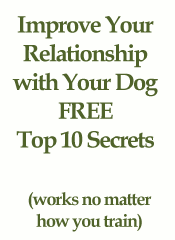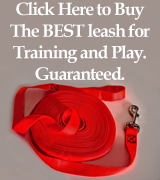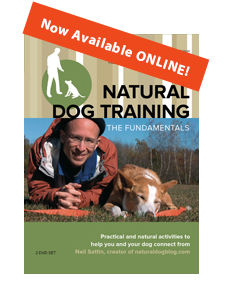Welcome all, especially to those of you who are visiting from the blog carnival. Here at NaturalDogBlog.com, we're primarily focused on techniques that utilize your dog's deepest instinct (the prey instinct) and their emotional perception of the world to achieve obedience behaviors and solve problems. This morning I'm going to teach you how to play the game of "Fetch-Tug" with your dog. This simple game will help you teach your dog to fetch and increase your dog's level of attraction to you (so that they feel good about coming straight to you when they're energized). In addition, 10-15 minutes of playing this game will give your dog a GREAT physical (and emotional) workout - with fitness potential for you as well, if you decide to really get into it.
We discussed how to play tug of war with your dog earlier, and since "Tug" is an important part of "Fetch-Tug" it'll be important for you to familiarize yourself with the correct way to play tug-of-war with your dog. However, even if you haven't yet taught yourself (and your dog) how to play tug-of-war the right way, that's ok - playing Fetch-Tug will be a perfect opportunity for you to practice. My article on tug of war gives you a lot of information about how to develop an ideal game of tug with your dog - but here's a quick review of the rules:
- Have two identical toys for tugging (and fetching). I use two 20-or-so inch lengths of rubberized garden hose - but whatever you use make sure that the items are identical and easy for you to grab on while your dog is grabbing the other end.
- Encourage your dog to bite one of the toys. Remember that you might have to be more "prey-like" in order to get your dog to take hold.
- LET YOUR DOG WIN. I can't emphasize that enough. Give your dog lots of praise when they win, and notice how obviously good they're feeling.
- Pull out tug toy #2 and encourage your dog to bite that toy. Your dog will drop toy#1 (which you will ultimately pick up). Repeat the game with tug toy #2.
- Quit playing the game while your dog is still interested. Stopping "early" will build your dog's enthusiasm for the next time that you play.
IMPORTANT DISCLAIMER: Playing games like tug and Fetch-tug with your dog involve your dog's teeth, which are sharp and potentially dangerous. Take the appropriate precautions when playing (ie remove loose jewelry, wear clothing that lets you move freely and with confidence, etc.) and at all times PAY ATTENTION! If you cannot be completely focused on your game with your dog then DON'T PLAY. Also, these games are for adults, not children, to play with dogs.
OK, so you have two identical tug toys. You also have a nice long lead attached to your dog's collar. Here's what you do to play Fetch-tug.
- Encourage your dog to bite one of the tug toys. However, don't let your dog get the toy. Your aim is to arouse your dog's interest in the toy - so don't get too carried away with the teasing.
- When your dog is interested in getting the toy, say "Ready" and then throw the toy so it lands 10-15 feet away from you. You want your dog to learn the game first, so don't worry about throwing the toy too far for now - just a few feet away.
- Your dog will (hopefully) chase after the toy and grab it - excellent! For the moment we'll assume this happens. After I finish describing the game in its entirety, I'll address some possible issues that you might have and offer some solutions.
- Use toy #2 to encourage the dog to come back in your direction. In your mind, what this means is that the game is now ABOUT toy #2, not toy #1. You don't care anything about toy#1. What you want your dog to do, at this point, is come in your direction, hopefully with toy #1 still in their mouth.
- Encourage your dog to try to get toy #2 when they get to you. At the instant that they drop toy #1 when their attention switches to toy #2, say "Out!" (or "Drop" - or whatever you want your keyword to be). It is important that you say the word at the instant (or just after) they actually drop the toy. You are not commanding them to drop the toy, you are responding to the fact that they have just dropped the toy, and you want them to get used to hearing the word at the instant that they experience the FEELING of having dropped the toy. Eventually the word will work as a command - but not for AWHILE. Remember that teaching them to play fetch is the overall objective, so don't obsess over teaching them the "drop" command. It will happen naturally as you play the game consistently.
- Once your dog is interested in toy #2, do the same thing that you did with toy #1, only this time throw the toy 10-15 feet in the OPPOSITE direction. Imagine yourself standing at the midpoint of a line that extends 15 feet in either direction. You are going to alternate throwing first in one direction, then the other. Thus, while you stand relatively still, your dog will be running back and forth, back and forth - crossing where you are.
- Every so often, when your dog approaches where you are, try to grab the tug toy, and start pulling on it - play a quick game of tug, but remember to let your dog WIN. This is the "Tug" portion of Fetch-Tug. You might have to back away from your dog to encourage them to get close enough to you so that you can grab hold of the toy. Also, try holding your hand out palm-up instead of palm-down when you're making your grab.
- After your dog wins, pull out the other toy and quickly transition your dog's attention back to the toy you have. Resume the Fetch portion of the game.
- Gradually increase the distance that you're throwing the toy. I start at 10-15 feet, and gradually work my way up to 100 feet or so - or as far as I can throw the particular tug object. Remember to BE GRADUAL.
- Try to keep your dog in motion. Eventually, your dog will run to get the toy, grab it, come running right back at you, and, at the SIGHT of the new tug toy (in your possession), they will drop the toy they currently have in preparation for the new chase. If you work on your timing, you can get your dog to drop the toy right where you are and immediately toss toy #2, keeping your dog moving throughout the game.
- Quit while you're ahead. That is, stop playing while your dog is still excited about the game, so as to build your dog's enthusiasm for the next time you play.
So that's the game of Fetch-Tug. Clearly your dog will be getting quite a workout. If you take time during the game to encourage your dog to chase you (and really get a good run in), then you'll be getting in some good cardio time as well. Remember, you want your dog to chase you - you absolutely do NOT want to be chasing your dog. As you play the game, you are increasing your dog's emotional state, and you should find that they get quite energized. Notice, though, that since you throw the toy in opposite directions each time, your dog has to keep running back in YOUR direction, directly at you, in this energized state. Practicing this will help your dog overcome their natural resistance to you during energized moments - and be immensely powerful when you're trying to call your dog to you during those moments (rather than having them take off after a deer, another dog, etc.).
Incorporating Tug-of-War into the game is an important component in cementing your dog's attraction to you as well. Aim for playing tug maybe one out of every five times that you toss the toy.
A few common questions and answers:
What do I do if my dog isn't interested in the toy? Revisit the article on tug of war to explore ways of getting your dog interested. You might also try using a toy that's floppier, softer - or try one with a squeaker, giving it a few squeaks before you toss the toy. Just make sure that it's an appropriate tug toy (i.e. durable enough to withstand tugging, and long enough that you can safely grab it while your dog is clamped onto the other end). Pretend that the toy is a little squirrel, and try to get your dog to chase you as you're holding the toy and tempting them with it. Start with even shorter tosses. As your dog gets interested in the game they will care less and less about what toy you're actually using.
What if my dog runs after the toy, then takes off with it in the opposite direction, or stops with it to chew on it? This is an interesting situation. The energy of the moment is too strong, and your dog is showing you their resistance to you during these moments of high energy - and it is MUCH easier for them to channel their energy into that little toy (which is a prey object for them) than it is for them to run towards you. Here's something to try that works about ninety percent of the time:
- Pretend that you're a predator. SLOWLY stalk towards your dog. Hold out an outstretched arm and point at your dog. Breath deeply and loudly. Move very slowly and deliberately. Your dog will probably be VERY interested in you at this point.
- Be ready now - at the INSTANT that your dog makes a move for their toy (remember, that's why they ran away from you in the first place - because it's easier for them to channel their drive into the toy than into you) take off in a sprint AWAY from your dog. At this point the emotional momentum of the moment (with your rapid change from predator into prey - as you run away from your dog) is too much for your dog to resist. Your dog SHOULD run right after you with the toy in their mouth.
- As soon as your dog is running towards you, try to engage their interest in the 2nd toy - the one that you have in your possession. Continue the game as outlined above.
What do I do if my dog loses interest in the game? You played too long. Stop playing, put the toys away, and NEXT time stop playing BEFORE your dog loses interest.
How do I END the game? When you're ready to end the game, grab the end of your dog's long lead, take a tasty treat out of your pocket/pouch, and trade that treat for the toy that your dog currently has. Put both toys away, and walk your dog, on lead, back to the house (or wherever you're headed next). Take some time to give your dog some long, slow, massaging strokes. It is important to end the game on this POSITIVE note - don't just command your dog to "drop it" without giving them something in return. Even better - don't command them at all - just give them the treat and take the toy once they've dropped it. Some relaxing massage...and then back to the house.
Incorporate Fetch-Tug into your daily repertoire. You now have two great games to play, Tug-of-War and Fetch-Tug, that not only provide your dog with great entertainment, but which also help them learn some important skills - primarily feeling safe around you and attracted to you when they are experiencing a high degree of emotional stimulation. Have fun with it - you are slowly becoming the calm, assertive MOOSE in your dog's life, which is the best relationship you could possibly have. Check out the link on becoming the moose to read about why the prey instinct is central to your dog's best behavior.
As always, if you have any questions, please leave them in the comments, or e-mail me (neil at naturaldogblog dot com). Thanks for stopping by!





Trackbacks/Pingbacks